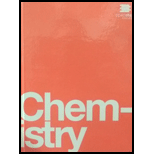
In glycolysis, the reaction of glucose (Glu) to form glucose-6-phosphate (G6P) requires ATP to be present as described by the following equation:
In this process, ATP becomes ADP summarized by the following equation:
Determine the standard free energy change for the following reaction, and explain why ATP is necessary to drive this process:
Want to see the full answer?
Check out a sample textbook solution
Chapter 16 Solutions
Chemistry by OpenStax (2015-05-04)
Additional Science Textbook Solutions
College Physics
Organic Chemistry (8th Edition)
Organic Chemistry
Chemistry: Structure and Properties
Introductory Chemistry (5th Edition) (Standalone Book)
Chemistry: Structure and Properties (2nd Edition)
- a) As stated in question 5a, glucose (C6H12O6(s)) is a source of cellular energy. Calculate the standard free energy for the metabolism of glucose: Given ΔG°C6H12O6(s) = -911kJ/mol; ΔG°O2(g) = 0kJ/mol; ΔG°CO2 = -394kJ/mol; ΔG°H2O(l) = -237kJ/molC6H12O6(s) + 6O2(g) ➝ 6CO2(g) + 6H2O(l) b) Cells couple the hydrolysis of adenosine triphosphate (ATP) into adenosine diphosphate (ADP) andinorganic phosphate (PO43–) to drive chemical reactions (i.e. as a source of chemical energy). The reaction is: ATP(aq) + H2O(l) ➝ ADP(aq) + PO43–(aq) Calculate K for this reaction if ΔG° = –30.5 kJ/mole. c) If all of the energy from glucose metabolism went into ATP synthesis from ADP and inorganicphosphate, how many molecules of ATP could be generated from each molecule of glucose?arrow_forwardPlease answer this question. For the aqueous reaction: dihydroxyacetone phosphate ↽−−⇀ glyceraldehyde−3−phosphatedihydroxyacetone phosphate the standard change in Gibbs free energy is Δ?°′=7.53 kJ/molΔG°′=7.53 kJ/mol. Calculate ΔG for this reaction at 298K when [dihydroxyacetone phosphate]=0.100 M and [glyceraldehyde-3-phosphate]=0.00200arrow_forwardGiven that the reaction of 4 NH3 (g) + 5 O2 (g) → 4 NO (g) + 3 H20 (g) ΔΗ - - 906 kJ What would AH for NO (g) + ? H20 (g) → NH3 (g) + O2 (g) be? 2. 906 kJ 226.5 kJ -226.5kJ 453 kJarrow_forward
- In glycolysis, the reaction of glucose (Glu) to form glucose-6-phosphate (G6P) requires ATP to be present as described by the following equation:Glu + ATP⟶G6P + ADP ΔG°298 = −17 kJIn this process, ATP becomes ADP summarized by the following equation:ATP⟶ADP ΔG°298 = −30 kJDetermine the standard free energy change for the following reaction, and explain why ATP is necessary to drive this process:Glu⟶G6P ΔG°298 = ?arrow_forwardIn glycolysis, glucose is broken down to yield energy. If the equilibrium constant of the isomerization of glucose-6-phosphate to fructose-6-phosphate is 0.5, would this reaction proceed in the forward or reverse direction? What is the free energy of the reaction? Using standard conditions (1 M) as an initial state, what are the equilibrium concentrations?arrow_forwardGiven that S(g) + O2(g) → SO2(g) A,G° = -300.1 kJ/mol-rxn 2 S(g) + 3 O2(g) → 2 SO3(g) A,G° = -742.1 kJ/mol-rxn calculate AG° of the following reaction: SO2(g) + 1/2 O2(g) → SO3(g) O -1042.2 kJ/mol-rxn O -71.0 kJ/mol-rxn O +2.47 kJ/mol-rxn +1042.2 kJ/mol-rxn O +71.0 kJ/mol-rxnarrow_forward
- ATP → ADP + Pi (ΔG°’ = -30.5 kJ/mol) In cells, the [ATP] is 0.5 mM, the [ADP] is 4.5 mM, and the [Pi] is 0.65 mM. Calculate the free energy change for ATP hydrolysis under cellular conditions. Enter the numerical value in units of kJ/mol and round to the nearest tenths place.arrow_forward6H2O (l) + 6CO2 (g) → C6H12O6 (s) + 6O2 (g) ΔH = +2803 kJ/mol Calculate the amount of sunlight energy required (in kJ) by a plant to synthesize 75.0 g of glucose (C6H12O6).arrow_forwardA student determines the value of the equilibrium constant to be 3.67×10-18 for the following reaction. Fe3O4(s) + 4H₂(g) →→→3Fe(s) + 4H₂O(g) Based on this value of Keq: AGO for this reaction is expected to be (greater, less) than zero. Calculate the free energy change for the reaction of 1.67 moles of Fe3O4(s) at standard conditions at 298K. AGᵒrxn KJarrow_forward
- Given the heat of formation of the following compounds: CO2(g) ΔfH° = -393.5 kJ/mol H2O(l) ΔfH° = -285.9 kJ/mol CH3OH(l) ΔfH° = -238.6 kJ/mol What is the value of ΔrH° for the reaction: CH3OH(l) + 3/2 O2(g) → CO2(g) + 2 H2O(l)arrow_forwardThe Keq for the isomerization of glucose-6-phosphate to fructose-6-phosphate is 0.504. What is the ΔG for the reaction if the concentration of glucose-6-phosphate is 0.01 M and the concentration of fructose-6-phosphate is 0.05 M? This reaction is in the cell (this is your temperature = 30 degree celcius ). the answer should be 0.588 kcal/mol - please show all steps I am not sure how to get that answerarrow_forwardWhat is the relationship between free-energy change for a reaction and it's equilibrium constant?arrow_forward
 Chemistry: Principles and ReactionsChemistryISBN:9781305079373Author:William L. Masterton, Cecile N. HurleyPublisher:Cengage Learning
Chemistry: Principles and ReactionsChemistryISBN:9781305079373Author:William L. Masterton, Cecile N. HurleyPublisher:Cengage Learning General Chemistry - Standalone book (MindTap Cour...ChemistryISBN:9781305580343Author:Steven D. Gammon, Ebbing, Darrell Ebbing, Steven D., Darrell; Gammon, Darrell Ebbing; Steven D. Gammon, Darrell D.; Gammon, Ebbing; Steven D. Gammon; DarrellPublisher:Cengage Learning
General Chemistry - Standalone book (MindTap Cour...ChemistryISBN:9781305580343Author:Steven D. Gammon, Ebbing, Darrell Ebbing, Steven D., Darrell; Gammon, Darrell Ebbing; Steven D. Gammon, Darrell D.; Gammon, Ebbing; Steven D. Gammon; DarrellPublisher:Cengage Learning Chemistry: The Molecular ScienceChemistryISBN:9781285199047Author:John W. Moore, Conrad L. StanitskiPublisher:Cengage Learning
Chemistry: The Molecular ScienceChemistryISBN:9781285199047Author:John W. Moore, Conrad L. StanitskiPublisher:Cengage Learning


